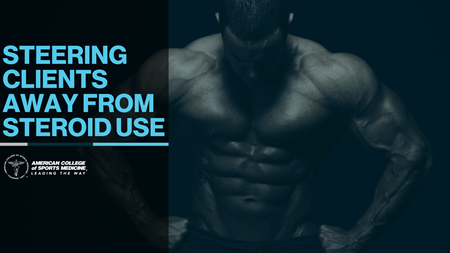Joe Sherlock, ACSM Copywriter |
Sept.
14, 2022

So you’ve got a client who’s asking about certain “extracurricular” substances. Or worse, you’re starting to recognize the signs that they’ve already added them to their repertoire.
If you’ve spent enough time in fitness facilities, you’ll have run into someone using performance-enhancing substances. They can sing a siren song to clients looking to make quick gains because, frankly, they work — a reality we can’t ignore. According to a 2021 ACSM consensus statement published in Medicine & Science in Sports & Exercise®, anabolic-androgenic steroids (AAS) confer significant gains in muscle strength, power and endurance.
However, the costs far outweigh the benefits — and not just physically. Let’s explore the issue.
How many people are on this stuff?
The research on rates of recreational AAS use is less than optimal. The elephant in the room, of course, is that gymgoers aren’t necessarily forthcoming about their “gear” status. Investigators generally have to rely on self-reported survey responses, putting us in a bit of pickle. That caveated, the range of gym attendees using AAS seems to lie somewhere between 3.5 and 80%.
Obviously we’re not operating with precision data here. You could run wind sprints between either end of that range. But even if we’re as conservative as possible, sticking with the absolute bare minimum figure, that means between three and four out of every 100 people who go to the gym use AAS. You’ve encountered it.
What do AAS do?
The answer is complex because what comprises AAS — and the other substances users take in conjunction with them — is complex. There is a wide swath of compounds and chemicals that fall into the category, from testosterone, testosterone derivatives and testosterone esters (a version of testosterone more easily absorbed into oils) themselves to designer AAS, selective androgen receptor modulators and human chorionic gonadotropin (which stimulates sperm and testosterone production).
However, overall, research indicates that AAS users see 5-20% increases in lean body mass, a significant boost that will inevitably be attractive to many potential users. Many AAS also reduce recovery time between exercise bouts, allowing users to add significantly more volume to their lifting regimen. AAS aren’t a magic potion, and users still need to train in order to realize results, but the effects are measurable and often appealing to a particular subset of gymgoers.
Why do people use AAS?
According to the ACSM consensus statement, many people use AAS not so much to increase their athletic performance but because of muscle dysmorphia. The mirror is lying to them, so to speak. Other reported reasons included a desire to improve recovery between workouts, receive social recognition, decrease body fat, increase the ability to protect oneself and to increase sex drive.
This isn’t an exhaustive list, but even from this sampling we can see there are clearly emotional factors at play, especially in the last two items.
What are the risks of AAS use?
Here we get to the heart of the matter. Besides infringing on the idea of fair play and sportsmanship in the athletic arena — a significant topic in its own right — AAS users risk serious physical and psychological consequences.
Physically, the risks run the gamut: heart attack and sudden cardiac death, blood-clotting abnormalities, stroke, liver damage, erectile dysfunction and reduced testicular size in men, clitoral enlargement and amenorrhea in women, acne, baldness, renal failure, and rhabdomyolysis.
Psychologically, AAS users may face depression, mood swings, insomnia, an increase in violent tendences, and a higher risk of suicide and even homicide.
Once again, this is only a small sampling of the available information, and the ACSM consensus statement covers these outcomes in much more detail.
Discouraging AAS use
In theory, the risks listed above should immediately dissuade people from using AAS, and yet plenty still do. How do we approach the subject in a way that actually reaches someone and effects change?
The tack to take will be different for each client, but there are some broad commonalities: First, bear in mind that for plenty of people who use or are interested in using AAS, there is a deeper psychological need at play. This makes discussions difficult because there’s often a vulnerability at the core of someone’s attraction to or use of these substances. Such vulnerabilities can cloud judgement and make people desperate for their desired result regardless of the risk.
One good strategy is to shift the client’s paradigm from thinking only in the present to considering life in the long term. (This can be more difficult with younger clients, but it’s still worth attempting.) Explain that AAS are counterproductive over the course of the lifespan, that what they may bring in in the present will have to be paid back with interest in the future. Emphasize also that, with time, the diet and exercise programming you can provide them with should show results so long as they stick with them. As much as they may want to see big changes Right Now, being diligent and persistent will pay off in the end.
Another tactic is to have clients consider something intangible that AAS use might take from them: seeing what their body is capable of on its own. That if they use AAS, they’ll never have the complete feeling of accomplishment that comes from achieving pure physical performance. AAS users will never know exactly how much of their results are from their own body’s expression of itself and how much are from chemical enhancement. Once you’ve crossed that bridge, there’s no going back.
Clients may worry that their body can’t give them the results their after without AAS, but encourage them to trust the process and watch as their physical systems rise to the occasion.